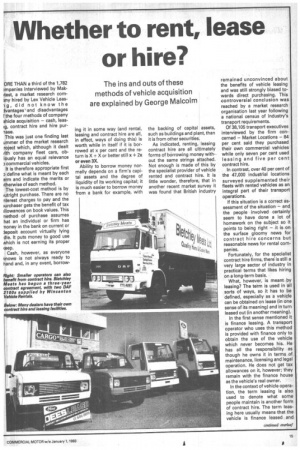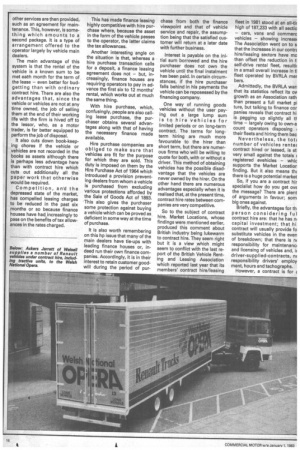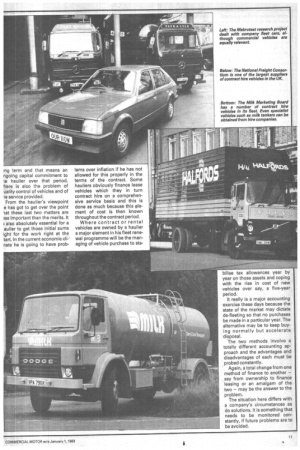Whether to rent, lease or hire?
Page 17

Page 18

Page 19

If you've noticed an error in this article please click here to report it so we can fix it.
The ins and outs of these methods of vehicle acquisition are explained by George Malcolm
ORE THAN a third of the 1,782 )mpanies interviewed by Makotest, a market research cornany hired by Lex Vehicle Leasg, did not know the ivantages`and disadvantages f the four methods of company ahicle acquisition — cash, leasig, contract hire and hire purlase.
This was just one finding last ummer of the market research roject which, although it dealt /Rh company fleet cars, obiously has an equal relevance ) commercial vehicles.
It is therefore appropriate first define what is meant by each arm and indicate the merits or otherwise of each method.
The lowest-cost method is by outright purchase. There are no nterest charges to pay and the iurchaser gets the benefit of tax illowances on book values. This nethod of purchase assumes hat an individual or firm has noney in the bank on current or ieposit account virtually lying dle. It puts money to good use Nhich is not earning its proper ceep.
Cash, however, as everyone knows is not always ready to hand and, in any event, borrow ing it in some way (and rental, leasing and contract hire are all, in effect, ways of doing this) is worth while in itself if it is borrowed at x per cent and the return is X + X or better still x 2x or even 3X.
Ability to borrow money normally depends on a firm's capital assets and the degree of liquidity of its working capital; it is much easier to borrow money from a bank for example, with the backing of capital assets, such as buildings and plant, than it is from other securities
As indicated, renting, leasing contract hire are all ultimately forms of borrowing money without the same strings attached. Not enough is made of this by the specialist provider of vehicle rented and contract hire. It is little wonder, thereforejl that in another recent market Survey it was found that British industry
remained unconvinced about the benefits of vehicle leasing and was still strongly biased towards direct purchasing. This controversial conclusion was reached by a market research organisation last year following a nationalcensus of industry's transport requirements.
Of 38,105 transport executives interviewed by the firm concerned — Market Locations — 84 per cent said they purchased their own commercial vehicles while only seven per cent used leasing and five per cent contract hire.
In contrast, over 40 per cent of the 47,000 industrial locations surveyed supplemented their fleets with rented vehicles as an integral part of their transport operations.
If this situation is a correct assessment of the situation — and the people involved certainly seem to have done a lot of homework on the subject so it points to being right — it is on the surface gloomy news for contract hire concerns but reasonable news for rental companies.
Fortunately, for the specialist contract hire firms, there is still a very large sector of industry in practical terms that likes hiring on a long-term basis.
What, however, is meant by leasing? The term is used in all sorts of ways, so it has to be defined, especially as a vehicle can be obtained on lease (in one sense of its meaning) and in turn leased out (in another meaning).
In the first sense mentioned it is finance leasing. A transport operator who uses this method is provided with finance only to obtain the use of the vehicle which never becomes his. He has all the responsibility as though he owns it in terms of maintenance, licensing and legal operation. He does not get tax allowances on it, however; they remain with the finance house as the vehicle's real owner.
In the context of vehicle operation, the term leasing is also used to denote what some people maintain is another form of contract hire. The term leasing here usually means that the vehicle is finance leased and other services are then provided, such as an agreement for maintenance. This, however, is something which amounts to a second package. It is a type of arrangement offered to the operator largely by vehicle main dealers.
The main advantage of this system is that the rental of the vehicle is a known sum to be met each month for the term of the lease — even better for budgetting than with ordinary contract hire. There are also the advantages that, since the vehicle or vehicles are not at any time owned, the job of selling them at the end of their working life with the firm is hived off to the lessor, who, as a motor trader, is far better equipped to perform the job of disposal.
It also cuts down book-keeping chores if the vehicle or vehicles are not recorded in the books as assets although there is perhaps less advantage here than with contract hire which cuts out additionally all the paper work that otherwise would be required.
Competition, and the depressed state of the market, has compelled leasing charges to be reduced in the past six months or so because finance houses have had increasingly to pass on the benefits of tax allowances in the rates charged. This has made finance leasing highly competitive with hire purchase where, because the asset in the form of the vehicle passes to the operator, the latter claims the tax allowances.
Another interesting angle on the situation is that, whereas a hire purchase transaction calls for a deposit, a finance leasing agreement does not — but, increasingly, finance houses are requiring operators to pay in advance the first six to 12 months' rental, which works out at much the same thing.
With hire purchase, which, confusingly, people are also calling lease purchase, the purchaser obtains several advantages along with that of having the necessary finance made available.
Hire purchase companies are obliged to make sure that vehicles are fit for the purpose for which they are sold. This duty is imposed on them by the Hire Purchase Act of 1964 which introduced a provision preventing dealers from whom a vehicle is purchased from excluding various protections afforded by the Sale of Goods Act of 1893. This also gives the purchaser some protection against buying a vehicle which can be proved as deficient in some way at the time of purchase.
It is also worth remembering on this hp issue that many of the main dealers have tie-ups with leading finance houses or, indeed run their own finance companies. Accordingly, it is in their interest to retain customer goodwill during the period of pur
chase from both the finance viewpoint and that of vehicle service and repair, the assumption being that the satisfied customer will return at a later date with further business.
Interest is payable on the initial sum borrowed and the hire purchaser does not own the vehicle until the final instalment has been paid. In certain circumstances, if the hire purchaser falls behind in his payments the vehicle can be reposessed by the financing company.
One way of running goods vehicles without the user paying out a large lump sum is to hire vehicles for limited periods or on long-term contract. The terms for longterm hiring are much more favourable to the hirer than short term, but there are numerous firms who will be willing to quote for both, with or without a driver. This method of obtaining vehicles has the possible disadvantage that the vehicles are never owned by the hirer. On the other hand there are numerous advantages especially when it is realised that, at the present time, contract hire rates between companies are very competitive.
So to the subject of contract hire. Market Locations, whose findings were mentioned earlier, produced this comment about British industry being lukewarm to contract hire. They seem right but it is a view which might seem to conflict with the last report of the British Vehicle Renting and Leasing Association which reported last year that its members' contract hire/leasing fleet in 1981 stood at an all-tir high of 187,233 with all sectio — cars, vans and commerc vehicles — showing increas( The Association went on to s that the increases in our contra hire/leasing sectors have mo than offset the reduction in ti self-drive rental fleet, resultil in a small overall increase in ti fleet operated by BVRLA mer bers.
Admittedly, the BVRLA wan that its statistics reflect its ov growth as an Association rath than present a full market pi ture, but talking to finance cor panies reveals that contract hi is pegging up slightly all tt time — largely owing to own-a count operators disposing i their fleets and hiring them bac Nevertheless, the toti number of vehicles rentec contract hired or leased, is sti very small against the totals ( registered evehicles — whic supports the Market Location finding. But it also means ON there is a huge potential market So, if you are a contract hir specialist how do you get OVE the message? There are plent of arguments in favour; som big ones against.
Briefly, the advantages for th person considering ful contract hire are: that he has n, capital investment; that hi contract will usually provide fo substitute vehicles in the even of breakdown; that there is n( responsibility for maintenanci and licensing of vehicles and, ir driver-supplied-contracts, n( responsibility drivers' employ ment, hours and tachographs.
However, a contract is for E prig term and that means an ngoing capital commitment to le haulier over that period. here is also the problem of uality control of vehicles and of le service provided.
From the haulier's viewpoint e has got to get over the point let these last two matters are ass important than the merits. It ; also absolutely essential for a aulier to get those initial sums ight for the work right at the tart. In the current economic cli-' nate he is going to have prob lems over inflation if he has not allowed for this properly in the terms of the contract. Some hauliers obviously finance lease vehicles which they in turn contract hire on a comprehensive service basis and this is done as much because this element of cost is then known throughout the contract period.
Where contract or rental vehicles are owned by a haulier a major element in his fleet renewal programme will be the managing of vehicle purchase to sta bilise tax allowances year by year on those assets and coping with the rise in cost of new vehicles over say, a five-year period.
It really is a major accounting exercise these days because the state of the market may dictate de-fleeting so that no purchases be made in a particular year. The alternative may be to keep buying normally but accelerate disposal.
The two methods involve a totally different accounting approach and the advantages and disadvantages of each must be probed constantly.
Again, a total change from one method of finance to another — say from ownership to finance leasing or an amalgam of the two — may be the answer to the problem.
The situation here differs with a company's circumstances as do solutions. It is something that needs to be monitored constantly, if future problems are to be avoided.
















































































